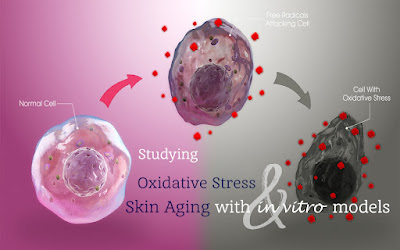In vitro Human Cell Culture Models for Studying Oxidative Stress and Skin Aging
Ageing is an inescapable process that causes a steady functional impairment in the large majority of organisms. Changes in the looks of skin, which becomes thin, less supple, wrinkled, and far less able to accomplish its defensive role, are one of the most visible indicators of ageing in people. Skin ageing is a multi-faceted phenomenon, and experts are still trying to figure out all of the intricate connections that occur. We do know, however, that it is influenced by both inherent (intrinsic) and external (extrinsic) variables. Intrinsic wrinkles are characterized by skin shrinkage, an enhanced predominance of the vasculature, decreased elasticity, and fine wrinkles, and are mostly genetically driven. Extrinsic causes comprise Exposure to UV radiation and pollution, which cause intense wrinkles, rough texture, and pigmentation anomalies.
A mismatch of pro-and anti-oxidants causes oxidative stress, which promotes quicker skin ageing, inflammation, and disease. Currently, researchers are using cell assays and primary cells to investigate the oxidative process and its link to skin ageing.
Oxidative Stress In Aging
Oxidative stress hastens the ageing process, yet oxidative mechanisms are also necessary for the body's physiological energy production. Some of the oxidants include free radicals, reactive oxygen species (ROS), and peroxides. Oxidative stress could become a self-fueling loop, in which initial stress causes instability of physiological functions, inflammation, and a dysregulated immune system, which leads to a variety of disorders that can cause more oxidative stress and inflammation. The skin, on the other hand, is the biggest organ in the human body and contains a vast amount of metabolic tissues.
According to research, ageing is caused by accumulated oxidative stress induced by free radicals produced in biological systems as a result of metabolism and UV radiation exposure (Stojiljkovic, 2014). The impression of skin ageing is caused by intrinsic collagen damage and a reduction in fibroblast size, both of which are induced by reactive oxygen species (ROS), which governs collagen metabolism.
Assays Used in Studying Oxidative Stress
Various assays for oxidative stress research are known, allowing researchers to examine DNA damage and changes in the energy state, as well as mutagenic, cancerous, and potential toxicity on cells and cellular processes. Assays are routinely used to detect oxidative stress markers, research cellular redox balance, comprising oxidant and antioxidant levels assessment, and search for pharmacologically significant inhibitors or therapeutic possibilities.
These assays include:
DNA Damage Assays
ROS assays
Anti-aging assays
Oxidase assays
Role of primary cells and cell models in anti-ageing studies
An additional technique for studying oxidative stress and ageing is to use primary cells and cell models. They assist researchers in better comprehending the complicated intercellular interaction that happens between different types of cells in the skin. Because two-dimensional cell models can't reproduce these biological systems, three-dimensional techniques are required. Organotypic skin models, for example, allow researchers to generate a realistic model by the approach that ensures multiple skin cell types in a three-dimensional matrix (Weinmullner, 2020). These 3D cell models can be customized to better understand certain skin types; for example, 3D cell cultures that imitate the ageing skin system can be created.
As research advances, more emphasis will be placed on basic research as well as models that allow for the screening of pharmacologic drugs in in vitro models that simulate the intricate skin system in replicable ageing models. 3D cell culture and high-throughput screening will be required for skin research.
If you are looking for primary cells for your research, get in touch with us at info@kosheeka.com for more information.



Comments
Post a Comment